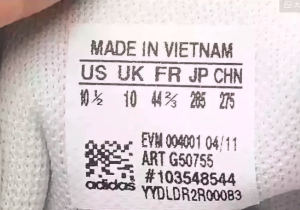In 2012, the last factory of adidas in mainland China was closed in suzhou.
In 2009, Nike Vietnam OEM completed the full capacity of China.
Today, Nike and adidas produce 50% in Vietnam and 20% in China.
In April 2018, uniqlo announced a shift of capacity from China to southeast Asia, with Vietnam responsible for 40 percent of total production.
Benefiting from the shift in the industry chain, Vietnam’s footwear exports reached $18 billion in 2017, making it the world’s second-largest footwear exporter after China.
Not only foreign brands, attracted by cheap labor, many shoe and cap apparel companies originally rooted in China’s guangdong and fujian provinces set off a wave of factory relocation to Vietnam.
Nanxuan, a Chinese apparel company that makes sweaters and other knitwear, will expand production in Vietnam. Nanxuan, based in huizhou, guangdong province, built a factory and started production outside ho chi minh city in 2015.
Bosideng, a Chinese manufacturer and seller of down jackets, is also expanding production in southeast Asia.
With the help of its capital partnership with itochu of Japan, bosiden has begun pilot production at a Vietnamese textile plant linked to itochu, with plans to expand further depending on production trends.
The reason for the transfer is not complicated, because labor costs to Vietnam can be nearly 60 percent cheaper.

It is not just China’s low-end industries that Vietnam is taking on.
In May 2018, samsung and Olympus closed their factories in shenzhen and moved to Vietnam.
Some media outlets even thought that the Japanese and Korean electronics industries were losing out in China, lamenting that they “saw the building collapse”, but did not know that samsung had invested $15 billion to build an unprecedented manufacturing base in the Saigon high-tech park.
Shut down factories in China as soon as the production lines are up and the staff are trained.
Microsoft moved nokia’s Beijing plant to Hanoi.
Intel is spending more than $1 billion on a high-tech park in Saigon, where it plans to deploy 80% of its global chip production.
Vietnam is trying to become a new manufacturing hub for the global electronics industry.
In 2017, Vietnam exported $45 billion worth of mobile phones, and a tenth of the world’s smartphones were made in the southeast Asian country.
And mobile phones have become the number one product made in Vietnam.
We often feel that we are the world’s no.1 in the whole industry chain, and the skilled workers are endowed with unique advantages. However, we forget that this is only a matter of a decade or more, and it is no worse than a decade for others. In addition, the population and industrial structure of southeast Asia have undergone great changes.
Of course, Vietnam is not without its shortcomings. Its industrial structure and population quality still lag behind that of China. However, with the deepening of trade frictions and the passage of time, the future is uncertain.
Vietnam alone accounts for nearly 10% of China’s exports, enough for the whole of southeast Asia plus India.